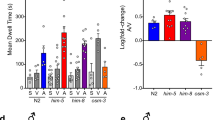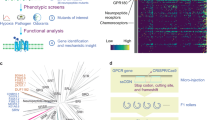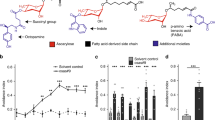Abstract
Social and solitary feeding in natural Caenorhabditis elegans isolates are associated with two alleles of the orphan G-protein-coupled receptor (GPCR) NPR-1: social feeders contain NPR-1 215F, whereas solitary feeders contain NPR-1 215V. Here we identify FMRFamide-related neuropeptides (FaRPs) encoded by the flp-18 and flp-21 genes as NPR-1 ligands and show that these peptides can differentially activate the NPR-1 215F and NPR-1 215V receptors. Multicopy overexpression of flp-21 transformed wild social animals into solitary feeders. Conversely, a flp-21 deletion partially phenocopied the npr-1(null) phenotype, which is consistent with NPR-1 activation by FLP-21 in vivo but also implicates other ligands for NPR-1. Phylogenetic studies indicate that the dominant npr-1 215V allele likely arose from an ancestral npr-1 215F gene in C. elegans. Our data suggest a model in which solitary feeding evolved in an ancestral social strain of C. elegans by a gain-of-function mutation that modified the response of NPR-1 to FLP-18 and FLP-21 ligands.
This is a preview of subscription content, access via your institution
Access options
Subscribe to this journal
Receive 12 print issues and online access
$209.00 per year
only $17.42 per issue
Buy this article
- Purchase on Springer Link
- Instant access to full article PDF
Prices may be subject to local taxes which are calculated during checkout






Similar content being viewed by others
References
Choe, J.C. & Crespi, B.J. (eds.) The Evolution of Social Behavior in Insects and Arachnids (Cambridge Univ. Press, Cambridge, 1997).
Wilson, E.O. Sociobiology (Belknap Press, Cambridge, Massachusetts, 1975).
Greenspan, R.J. & Ferveur, J.F. Courtship in Drosophila. Annu. Rev. Genet. 34, 205–232 (2000).
Young, L.J., Lim, M.M., Gingrich, B. & Insel, T.R. Cellular mechanisms of social attachment. Horm. Behav. 40, 133–138 (2001).
Krieger, M.J. & Ross, K.G. Identification of a major gene regulating complex social behavior. Science 295, 328–332 (2002).
Osborne, K.A. et al. Natural behavior polymorphism due to a cGMP-dependent protein kinase of Drosophila. Science 277, 834–836 (1997).
de Bono, M. & Bargmann, C.I. Natural variation in a neuropeptide Y receptor homolog modifies social behavior and food response in C. elegans. Cell 94, 679–689 (1998).
Hodgkin, J. & Doniach, T. Natural variation and copulatory plug formation in Caenorhabditis elegans. Genetics 146, 149–164 (1997).
Cheung, A.H., Huang, R.R. & Strader, C.D. Involvement of specific hydrophobic, but not hydrophilic, amino acids in the third intracellular loop of the beta-adrenergic receptor in the activation of Gs. Mol. Pharmacol. 41, 1061–1065 (1992).
Bluml, K., Mutschler, E. & Wess, J. Functional role of a cytoplasmic aromatic amino acid in muscarinic receptor-mediated activation of phospholipase C. J. Biol. Chem. 269, 11537–11541 (1994).
Coates, J. & de Bono, M. Antagonistic pathways in neurons exposed to body fluid regulate social feeding in Caenorhabditis elegans. Nature 419, 925–929 (2002).
Fitch, D.H.A. & Thomas, W.K. in C. elegans II (eds. Riddle, D.L., Blumenthal, T., Meyer, B. & Priess, J.R.) 815–850 (Cold Spring Harbor Laboratory Press, Cold Spring Harbor, 1997).
Koch, R., van Luenen, H.G.A.M., van der Horst, M., Thijssen, K.L. & Plasterk, R.H.A. Single nucleotide polymorphisms in wild isolates of Caenorhabditis elegans. Genome Res. 10, 1690–1696 (2000).
Hewes, R.S. & Taghert, P.H. Neuropeptides and neuropeptide receptors in the Drosophila melanogaster genome. Genome Res. 11, 1126–1142 (2001).
Rajpara, S.M. et al. Identification and molecular cloning of a neuropeptide Y homolog that produces prolonged inhibition in Aplysia neurons. Neuron 9, 505–513 (1992).
Tensen, C.P. et al. Molecular cloning and characterization of an invertebrate homologue of a neuropeptide Y receptor. Eur. J. Neurosci. 10, 3409–3416 (1998).
Feng, G. et al. Functional characterization of a Neuropeptide F-like receptor from Drosophila melanogaster. Eur. J. Neurosci. 18, 227–238 (2003).
Hinuma, S. et al. New neuropeptides containing carboxy-terminal RFamide and their receptor in mammals. Nat. Cell Biol. 2, 703–708 (2000).
Li, C., Kim, K. & Nelson, L.S. FMRFamide-related neuropeptide gene family in Caenorhabditis elegans. Brain Res. 848, 26–34 (1999).
Li, C., Nelson, L., Kim, K., Nathoo, A. & Hart, A.C. Neuropeptide gene families in the nematode Caenorhabditis elegans. Ann. NY Acad. Sci. 897, 239–252 (1999).
Sun, L., Philipson, L.H. & Miller, R.J. Regulation of K+ and Ca2+ channels by a family of neuropeptide Y receptors. J. Pharmacol. Exp. Ther. 284, 625–632 (1998).
Silverman, S.K., Lester, H.A. & Dougherty, D.A. Subunit stoichiometry of a heteromultimeric G protein–coupled inward-rectifier K+ channel. J. Biol. Chem. 271, 30524–30528 (1996).
Milligan, G., Marshall, F. & Rees, S. G16 as a universal G protein adapter: implications for agonist screening strategies. Trends Pharmacol. Sci. 17, 235–237 (1996).
Brundage, L. et al. Mutations in a C. elegans Gqα gene disrupt movement, egg-laying, and viability. Neuron 16, 999–1009 (1996).
Avery, L. & Horvitz, H.R. Pharyngeal pumping continues after laser killing of the pharyngeal nervous system of C. elegans. Neuron 3, 473–485 (1989).
Chalfie, M. et al. The neural circuit for touch sensitivity in Caenorhabditis elegans. J. Neurosci. 5, 956–964 (1985).
Mori, I. & Ohshima, Y. Neural regulation of thermotaxis in Caenorhabditis elegans. Nature 376, 344–348 (1995).
White, J.G., Southgate, E., Thomson, J.N. & Brenner, S. The structure of the nervous system of the nematode Caenorhabditis elegans. Phil. Trans. R. Soc. Lond. B. Biol. Sci. 314, 1–340 (1986).
Bargmann, C.I. & Horvitz, H.R. Chemosensory neurons with overlapping functions direct chemotaxis to multiple chemicals in C. elegans. Neuron 7, 729–742 (1991).
Sambongi, Y. et al. Sensing of cadmium and copper ions by externally exposed ADL, ASE, and ASH neurons elicits avoidance response in Caenorhabditis elegans. Neuroreport 10, 753–757 (1999).
Bargmann, C.I. & Mori, I. in C. elegans II (eds. Riddle, D.L., Blumenthal, T., Meyer, B. & Priess, J.R.) 717–738 (Cold Spring Harbor Laboratory Press, Cold Spring Harbor, 1997).
Driscoll, M. & Kaplan, J. in C. elegans II (eds. Riddle, D.L., Blumenthal, T., Meyer, B. & Priess, J.R.) 645–678 (Cold Spring Harbor Laboratory Press, Cold Spring Harbor, 1997).
de Bono, M., Tobin, D., Davis, M.W., Avery, L. & Bargmann, C. Social feeding in Caenorhabditis elegans is induced by neurons that detect aversive stimuli. Nature 419, 899–903 (2002).
Kubiak, T.M. et al. Differential activation of “social” and “solitary” variants of the Caenorhabditis elegans G protein-coupled receptor NPR-1 by its cognate ligand AF9. J. Biol. Chem. 278, 33724–33729 (2003).
Cowden, C. & Stretton, A.O. Eight novel FMRFamide-like neuropeptides isolated from the nematode Ascaris suum. Peptides 16, 491–500 (1995).
Davis, R.E. & Stretton, A.O. The motornervous system of Ascaris: electrophysiology and anatomy of the neurons and their control by neuromodulators. Parasitology 113 (Suppl.) 97–117 (1996).
Edison, A.S., Messinger, L.A. & Stretton, A.O. afp-1: a gene encoding multiple transcripts of a new class of FMRFamide-like neuropeptides in the nematode Ascaris suum. Peptides 18, 929–935 (1997).
Marks, N.J. et al. Isolation and preliminary biological assessment of AADGAPLIRFamide and SVPGVLRFamide from Caenorhabditis elegans. Biochem. Biophys. Res. Commun. 286, 1170–1176 (2001).
Nurrish, S., Segalat, L. & Kaplan, J.M. Serotonin inhibition of synaptic transmission: Gαo decreases the abundance of UNC-13 at release sites. Neuron 24, 231–242 (1999).
Denver, D.R., Morris, K. & Thomas, W.K. Phylogenetics in Caenorhabditis elegans: an analysis of divergence and outcrossing. Mol. Biol. Evol. 20, 393–400 (2003).
Sulston, J. & Hodgkin, J. in The Nematode Caenorhabditis elegans (ed. Wood, W. B.) 587–606 (Cold Spring Harbor Laboratory Press, Cold Spring Harbor, 1988).
Jansen, G., Hazendonk, E., Thijssen, K.L. & Plasterk, R.H. Reverse genetics by chemical mutagenesis in Caenorhabditis elegans. Nat. Genet. 17, 119–121 (1997).
Feng, G. et al. Cloning and functional characterization of a novel dopamine receptor from Drosophila melanogaster. J. Neurosci. 16, 3925–3933 (1996).
Van Renterghem, C. et al. GABA receptors induced in Xenopus oocytes by chick brain mRNA: evaluation of TBPS as a use-dependent channel blocker. Brain Res. 388, 21–31 (1987).
Davis, M.W. et al. Mutations in the Caenorhabditis elegans Na,K-ATPase alpha-subunit gene, eat-6, disrupt excitable cell function. J. Neurosci. 15, 8408–8418 (1995).
Avery, L., Raizen, D. & Lockery, S. in Caenorhabditis elegans: Modern Biological Analysis of an Organism (eds. Epstein, H.F. & Shakes, D.C.) 251–269 (Academic Press, San Diego, 1995).
Mello, C.C., Kramer, J.M., Stinchcomb, D. & Ambros, V. Efficient gene transfer in C. elegans: extrachromosomal maintenance and integration of transforming sequences. Embo J. 10, 3959–3970 (1991).
Clark, S.G., Lu, X. & Horvitz, H.R. The Caenorhabditis elegans locus lin-15, a negative regulator of a tyrosine kinase signaling pathway, encodes two different proteins. Genetics 137, 987–997 (1994).
Okkema, P.G., Harrison, S.W., Plunger, V., Aryana, A. & Fire, A. Sequence requirements for myosin gene expression and regulation in Caenorhabditis elegans. Genetics 135, 385–404 (1993).
Fukushige, T., Hawkins, M.G. & McGhee, J.D. The GATA-factor elt-2 is essential for formation of the Caenorhabditis elegans intestine. Dev. Biol. 198, 286–302 (1998).
Acknowledgements
We are grateful to R. Plasterk for allowing us to screen his C. elegans deletion library; Y. Kohara for flp-21 cDNAs; S. Baird, H. Kagawa, B. Fixsen, W. Sudhaus, A. Fodor, V. Ambros and W. Wood for wild isolates of C. briggsae and C. remanei and the Caenorhabditis Genetics Center for strains used in this work. We thank S. Baird, N. Tremain, G. Robinson and M. Sokolowski for comments on the manuscript and C. Bargmann, H. Baylis, C. Ferguson and B. Olofsson for discussion. This work was supported by the Medical Research Council (M.d.B.), the Biotechnology and Biological Sciences Research Council (P.E.) and grants from the National Science Foundation and National Institutes of Health (C.L.).
Author information
Authors and Affiliations
Corresponding author
Ethics declarations
Competing interests
The authors declare no competing financial interests.
Supplementary information
Supplementary Fig. 1.
FaRPs encoded by flp-18 and flp-21 activate NPR-1. Membrane currents from Xenopus oocytes injected with cRNAs for GIRK 1, GIRK 2 and NPR-1 isoforms. Trace (a) is from an oocyte injected with NPR-1 215F cRNA, whereas in trace (b) the oocyte was injected with NPR-1 215V cRNA. The oocytes were clamped at -80 mV and the currents monitored before and after the application of a high K+ saline (open bars), during which time the peptide (1 μM) was also applied (solid bars). FLP-21 refers to the peptide GLGPRPLRFamide, whereas FLP-18 refers to the peptide EMPGVLRFamide. Both peptides activated GIRK currents in oocytes expressing the NPR-1 215V receptor, but the currents induced by FLP-21 are three times larger than those induced by FLP-18. In contrast, only FLP-21 activated GIRK currents in oocytes expressing the NPR-1 215F receptor. The two traces shown in each panel are from the same oocyte, with a gap of 400 s between each trace. (PDF 54 kb)
Supplementary Fig. 2.
Representative intracellular recordings from C. elegans pharyngeal muscle showing the effects of FLP-18 and FLP-21 peptides on action potential frequency in animals expressing npr-1 transgenes under the control of the heat-shock promoter. Both the FLP-21 (a and c) and the FLP-18 EMPGVLRFamide (b and d) peptides induced a larger inhibition of action potential frequency in heat-shocked (+HS) animals expressing NPR-1 compared to non-heat-shocked controls (-HS). In all examples peptides were applied at a concentration of 10-10 M for 1 minute, as indicated by the horizontal bar. The NPR-1 receptor isoform tested is indicated above each panel. 500 nM 5HT was included in the perfusate to give a background firing rate against which to measure inhibition. (PDF 120 kb)
Rights and permissions
About this article
Cite this article
Rogers, C., Reale, V., Kim, K. et al. Inhibition of Caenorhabditis elegans social feeding by FMRFamide-related peptide activation of NPR-1. Nat Neurosci 6, 1178–1185 (2003). https://doi.org/10.1038/nn1140
Received:
Accepted:
Published:
Issue Date:
DOI: https://doi.org/10.1038/nn1140
This article is cited by
-
Host-mediated RNAi for simultaneous silencing of different functional groups of genes in Meloidogyne incognita using fusion cassettes in Nicotiana tabacum
Plant Cell Reports (2021)
-
Pharmacological and functional similarities of the human neuropeptide Y system in C. elegans challenges phylogenetic views on the FLP/NPR system
Cell Communication and Signaling (2019)
-
Bright split red fluorescent proteins for the visualization of endogenous proteins and synapses
Communications Biology (2019)
-
C. elegans collectively forms dynamical networks
Nature Communications (2019)
-
Regulation of hyperoxia-induced social behaviour in Pristionchus pacificus nematodes requires a novel cilia-mediated environmental input
Scientific Reports (2017)



